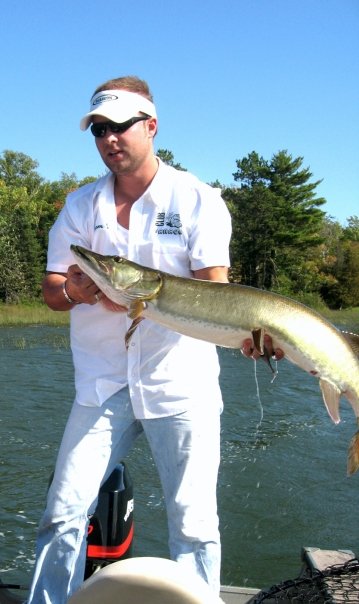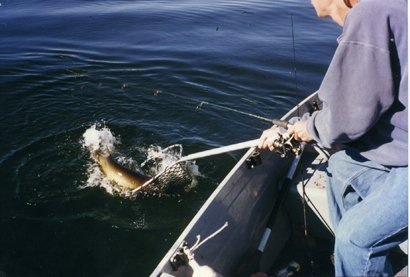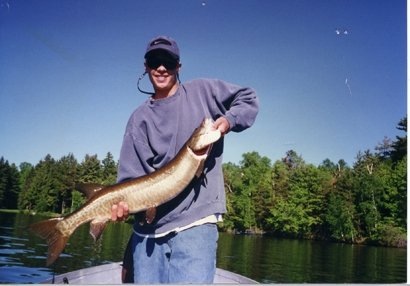Poetry in Motion – Techniques in Muskie Lure Retrieval
Category: article
Feb 13th, 2014 by OutdoorsFIRST
Modified Feb 13th, 2014 at 12:00 AM
When I first started muskie fishing I had already been avidly multi-specie angling for nearly 20-years, since I was old enough to hold a snoopy pole. I would occasionally fish muskie with my Dad when I was younger and sometimes I was successful, but back then I threw one of the three bucktails that I had been handed down and I used a spinning outfit. I always admired muskies and the anglers who pursued them.
 |
|
|
|
When I was younger I would spend a week at a time with my Dad and my Grandparents on Big St. Germaine Lake in Vilas County, Wisconsin. We would be anchored in our 16′ aluminum v-hull with my Grandpa at the stern, my Dad at the bow and me in the middle, quietly dragging live bait along the weed edges and watching slip-bobbers. Meanwhile, a sparkly boat with two people casting heavy tackle specifically geared for muskie would pass by now and again, and even on a couple of occasions we would witness one of them land a fish. It was back then that I was first intrigued by the rhythmic cadence by which those anglers would work the action of their lures and fluid motion of their figure-eights. It looked so actively involved and coordinated, artistic even.
I know, I know, artistic seems like an odd way to interpret technique, but even as I re-read the last sentence of the previous paragraph I can find no better way to capture what I remember thinking at the time. Like poetry in motion, there seemed to be a rhyme and reason for each snap, twitch, pull and sweep of the rod on every cast. I looked up to those strangers in those fancy boats and I based that primarily on the allure of their techniques.
I started casting artificial baits more and more by the middle of my teen years and admittedly did my best to replicate the techniques I had witnessed so many muskie anglers do, only I still used a spinning outfit and I wasn’t necessarily targeting muskies all the time. I’m sure I looked pretty silly to anyone who may have caught a glimpse of me, and rightfully so. Looking back at those younger years I may have been trying to look more advanced than I actually was. I had willingly left my comfortable niche of live bait rigging to primarily using hard plastics and wood.
My primary fishing partner was my Dad and he’d taught me everything I had learned up until that point, so learning artificials was a game changer for me and I would have to teach myself. My Dad bought me a large Grandma Bait I had picked out when I was 13-years old and took me to a public shore fishing spot on Rock Lake in Lake Mills, WI.
There were no muskie in Rock Lake, but that wasn’t the objective of the trip. I remember it was really windy that day and the waves were pounding into the shoreline we were on. I casted a few times but didn’t get much distance due to the wind, and on the retrieve the lure was digging into the sand on the bottom so I couldn’t feel the action. My dad lay down on the grass to relax his sore back and I took off my shoes and socks to wade out a little ways to reach deeper water with my new lure. We didn’t have very stiff gear back then so the rod would really bend on each cast. I just reeled the lure straight in each time, but I least I was getting it wet. I got pretty wet myself, I seem to recall, those waves were no joke.
I suppose my background in fishing gave me this sense of pride or ego that I could learn this trade on my own. I wouldn’t ask anyone I recognized as being more advanced than me because I always wanted to be better than I really was and I thought by asking it would show how lost I really was. When you were young, you wished you were older. Now that you’re older, you wish you were younger. For me this concept was very much alive in the way of my eagerness to catch more muskies consistently, but I was still young and new to the trade. This was a downfall for me in many ways, but I learned a lot through trial and error and attribute much of what I’ve learned by now to the old me.
I bought my first baitcasting outfit with residual funds left over from my student loans specifically intended for living expenses beyond the cost of tuition. I picked up a few muskie lures I knew nothing about from a clearance bin and used the big gamefish net my Grandpa had left behind to me and suddenly I was muskie fishing.
Throwing bucktails came easy to me. I had learned how to navigate inline spinners through weeds and river currents over the last several years fishing pike in lakes and smallmouth bass in local rivers and streams. The only difference now was I was using spinners five times the size I was used to so I had to acclimate to speed variations, but I caught on quickly to that. It was the hard baits that intimidated me the most.
One of the lures I had picked up from that clearance bin was a WTD top-water bait, of which I had no idea was meant to be fished on the surface at the time. I realized pretty quickly it wasn’t meant to sink or dive, so I started straight retrieving it slowly and giving it a “pop” once in a while to make it change the cadence a little bit. It wasn’t until that lure already had some hours on the water before I caught on to the occasional side-to-side action that came from those “pops” I was giving it. What to me had been just coincidence was actually by design for the lure to move the way it did, and I really had some fun with that bait after I learned how to use it. I also learned quickly after the importance of a good net as Grandpa’s old hand-me-down was dry rotted. Dry rotted net bags down hold big fish very well.
 |
|
|
|
I was fishing out of a canoe on Escanaba Lake north of Sayner, Wisconsin, back in my single-digit years with my Dad. There were submerged stumps in a small bay just northeast of the island and one of those stumps had a sucker pattern Suick hooked on with the braided line snapped just above the wire leader. I had held on to that lure ever since that day, only to cast it for the first time well over a decade later, and yes, with its original wire leader.
I couldn’t really tell you what I was doing with that bait, but I can tell you I was confused and frustrated at the same time. I hadn’t heard of the phrase, “dive-and-rise” by this point, and to be honest I couldn’t say how long it would have taken for me to recognize had I not encountered someone throwing a Suick a couple of years later. Right then and there I decided I had better pull that bait out, blow off the dust and try to imitate what the other guy was doing.
He used a steady and fluid snapdown motion with his rod and he made it look easy. I tried and it hurt my wrist. I kept digging the tip of the rod into the water and banging it against the gunnel of the boat, which was aggravating to say the least. When I finally learned how to leverage the rod with my forearm and less aggressive wrist movement, a light bulb turned on in my mind. Learning how to move the rod comfortably was the greatest advancement for me. From there I could experiment with all of the other odd shaped lures I had accumulated and finally develop some confidence in them based on the improved action I was working to perfect.
I feel like a lot of guys restrict their muskie arsenal of certain lures because they aren’t sure how to work them properly. There’s no bigger buzz kill on the water than having a total lack of confidence in what you’re throwing.
 |
|
|
|
Today, I have achieved more than I ever knew that I would in fulfilling personal goals accomplishments in the way of muskie fishing. I caught on to those techniques I admired watching when I was younger and I’d be lying if I said I don’t still admire watching people muskie fish today. I still think technique involved with muskie fishing is a form of art, or poetry in motion for lack of my own unique bundle of paraphrasing words. I just might enjoy watching people muskie fish as much as I enjoy doing it myself because it’s a pretty sight to see. My ego has been bruised enough times by failed opportunities that I’ve let most of it go by now; there’s no sense in holding on to something that hurts you so much.
If there’s one thing I’ve learned that I can teach as a lesson to anyone intimidated by certain lures and how to use them, it’s the cliche statement that there really is no wrong way to work a muskie lure, just some ways work better than others.